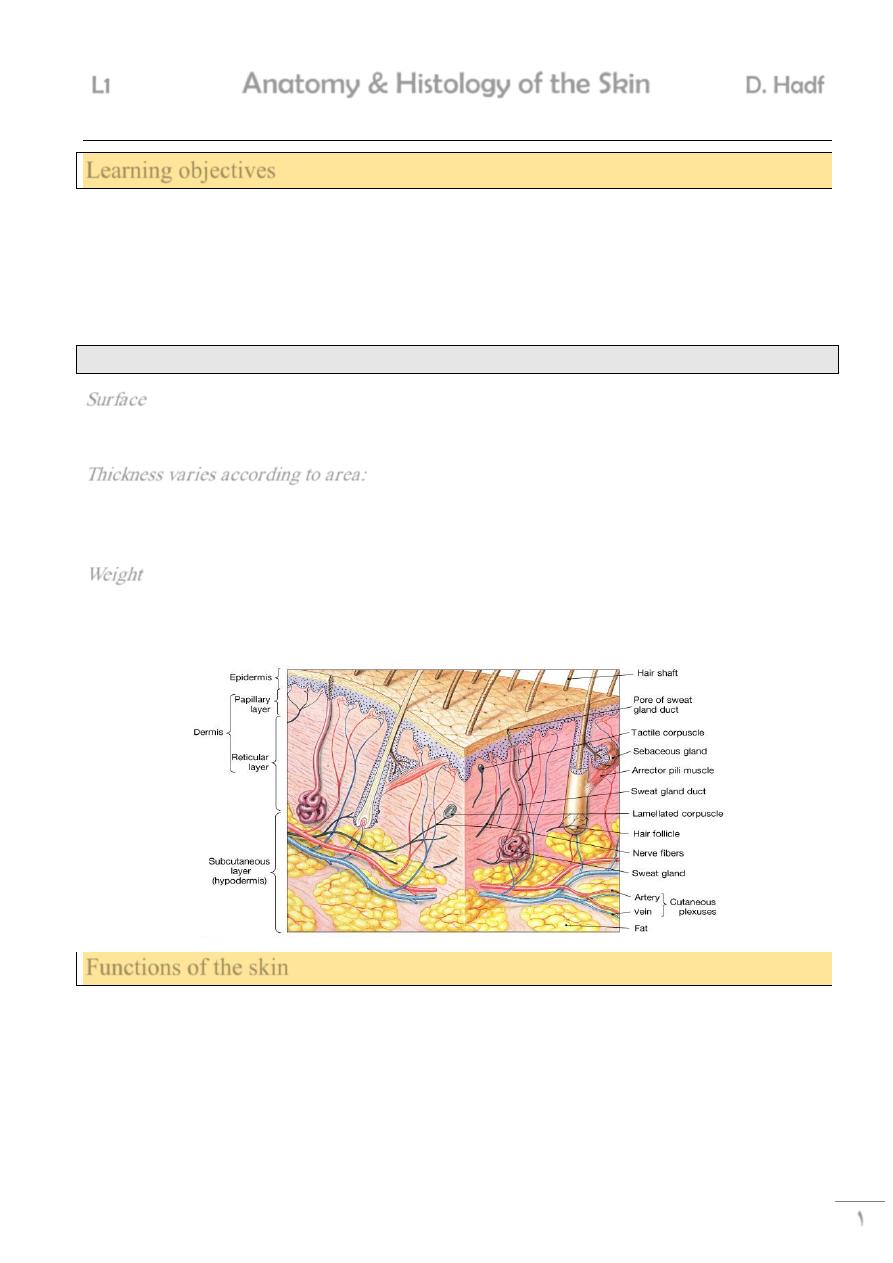
1
L1
Anatomy & Histology of the Skin
D. Hadf
Learning objectives
By the end of this lecture; the student should be able to:
1. List the components of the integumentary system, including their physical relationships.
2. Specify the functions of the integumentary system.
3. Describe the main features and functions of the epidermis and dermis.
4. Explain the structure and function of the various skin appendages.
Largest organ in the body
Surface
About 2 sq. meters
Thickness varies according to area:
0.2-0.5 mm on eyelid & prepuce
3-5 mm on palm & sole
Weight
4-5 kg
20 kg with hypodermis
Functions of the skin
The most important function is protection:
o Serving as a barrier against infection, UV light & disease
Helping to regulate body temperature
Removing waste products from the body
Vitamin D
3
synthesis
Sensory organ
Calorie reserve & heat insulation
Beauty organ
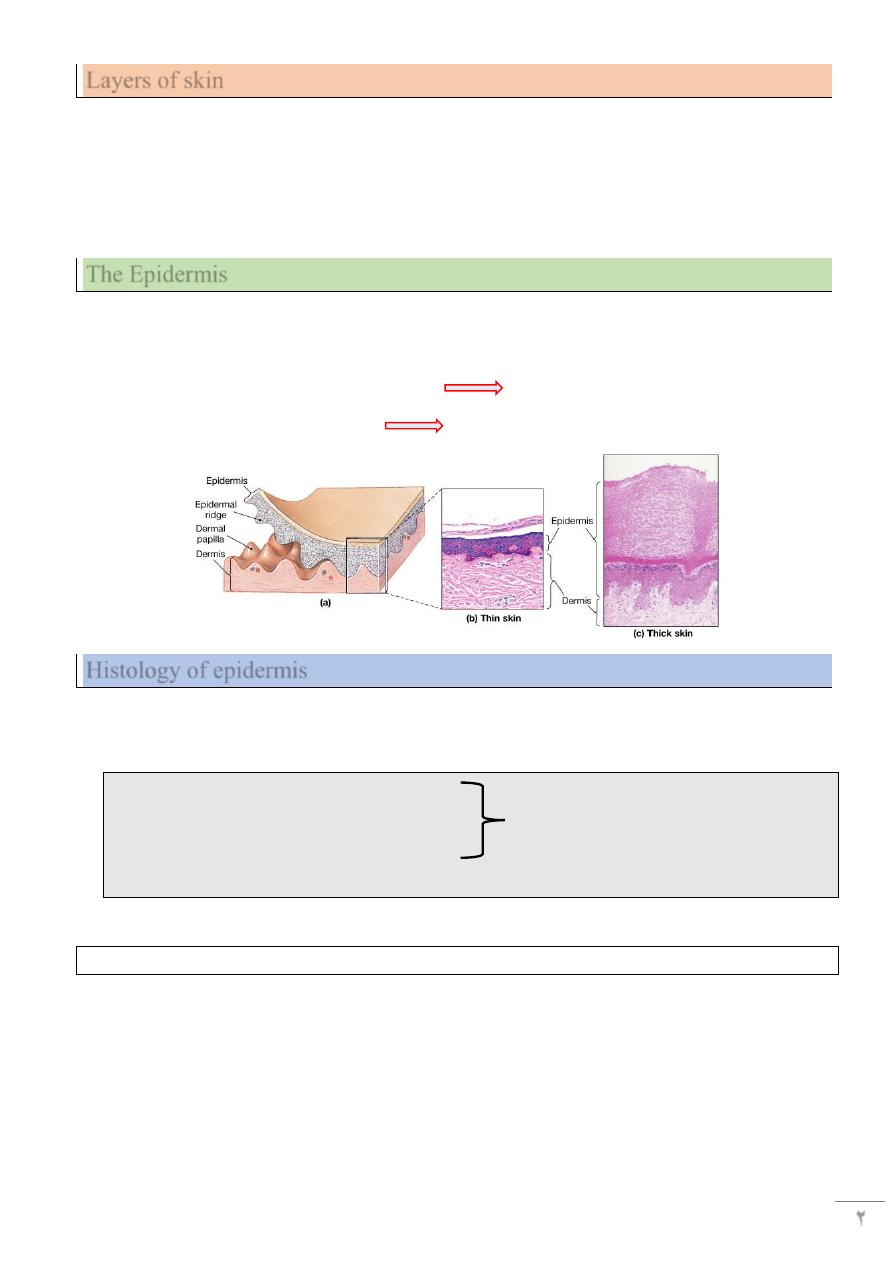
2
Layers of skin
Epidermis
Dermis
Subcutaneous fatty layer:
not part of skin
The Epidermis
o The epidermis is the outer most layer of the skin
o composed of layers keratinocytes, some undergo rapid mitosis
• Thin skin = four layers (strata) as in hairy skin
• Thick skin = five layers as in glabrous skin (palm & sole)
Histology of epidermis
Avascular stratified squamous epithelium
1- Keratinocytes: arranged in 5 layers
o Stratum germinativum (basal cell layer)
o Stratum spinosum (prickle cell layer)
o Stratum granulosum (granular cell layer)
o Stratum lucidum: only in palm & sole
o stratum corneum(horny layer)- non-viable epidermis ----------
2- Dendritic cells: melanocytes, Langerhans's cells, merkel’s cells
The ultimate function of epidermis is to produce keratin
o As new cells are produced, they push older cells to the surface of the skin where they
become flattened, lose their cellular content & start making keratin
o It is a tough fibrous protein which forms the basic structure of hair, nail & skin
o Eventually the keratin producing cells(keratinocytes) die & form a tough, flexible,
waterproof covering of the surface of the body
o This is shed or washed away once every 14-28 days
Viable epidermis
Non-viable epidermis
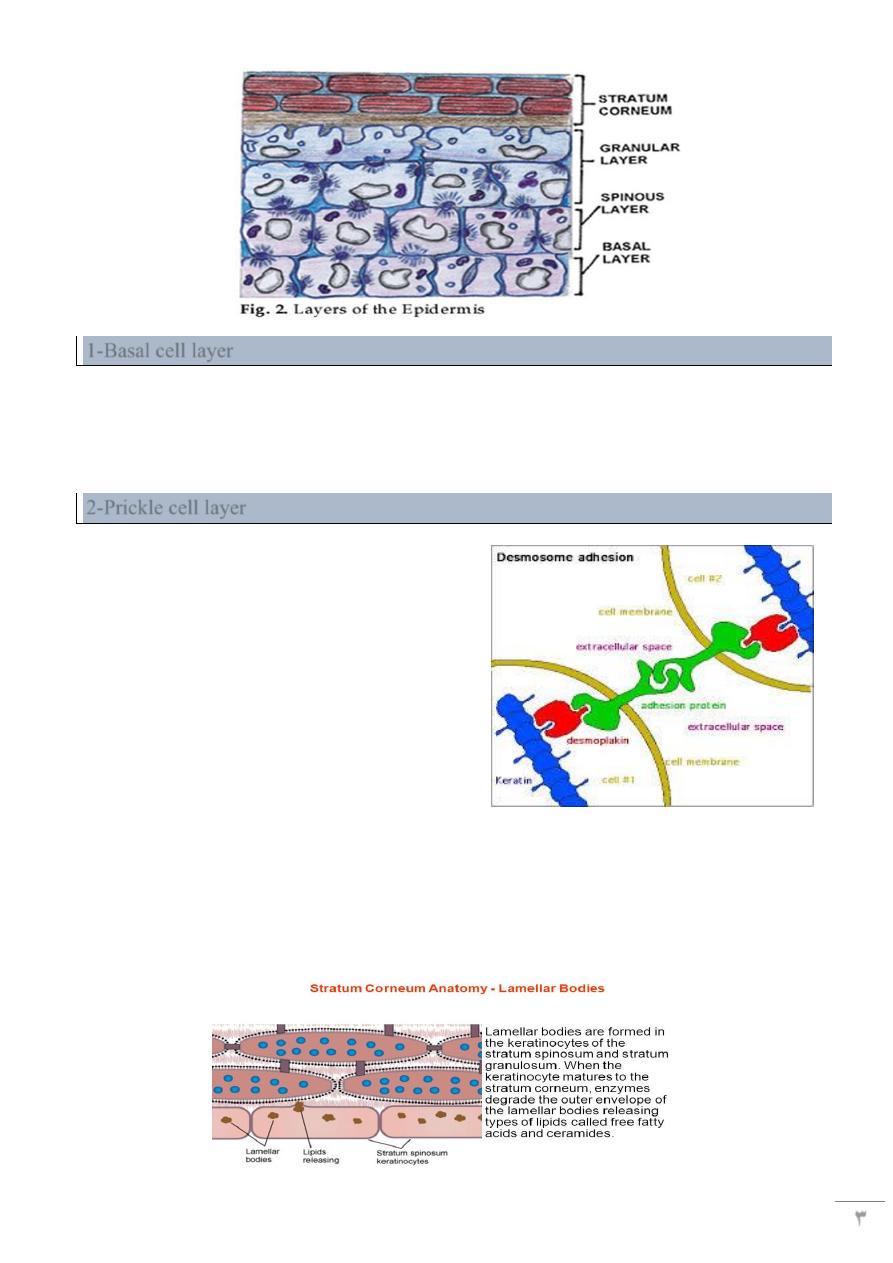
3
1-Basal cell layer
o Single layer, tall columnar cells, have nuclei & all organelles
o Site of DNA synthesis & mitosis
o Connected to each other by desmosomes & to basement membrane by
hemidesmosome
2-Prickle cell layer
5-20 layers, polygonal, nucleated, cytoplasm
become full of keratin bundles that are attached
to desmosomes: which are small interlocking
cytoplasmic processes which are thickenings on
the cell membrane of two opposing cell surfaces,
allowing the sliding of adjacent cells on each
other without separation upon trauma, links are
so strong that dead cells are shed in sheets not
individually.
The upper part of this layer contain lamellar granules (Odland’s bodies, keratinosomes) which
contain lipids & polysaccharides & their contents are discharged into the intercellular space at
the interface with granular layer
Forming the hydrophobic barrier
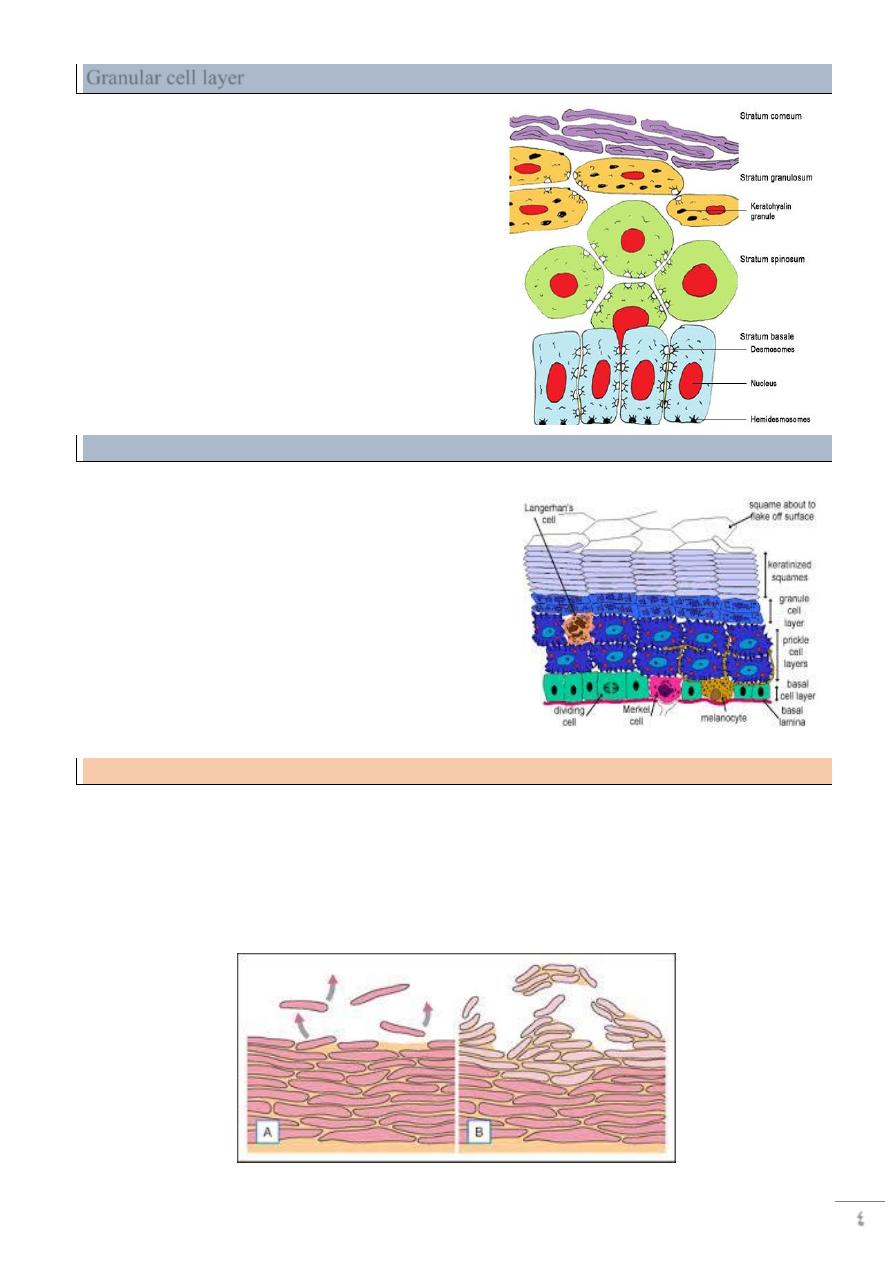
4
Granular cell layer
3-10 layers, flattened cells, cytoplasm
full of basophilic keratohyaline granules
Dissolution of nucleus & other cell
organelles
Keratin filaments in large bundles
Keratinosomes migrate to the periphery
of cells & discharge their lipid content
Horny cell layer
Flattened cells arranged in vertical stacks
that have lost nuclei & cellular organelles
Keratin filaments arranged into macro
fibers under influence of fillagrin
Highly insoluble cornified envelope within
plasma membrane
Desmosomes are lost
Epidermal cell cycle
After reaching the surface, corneocytes are shed continuously being replaced by
newer cells from beneath
The whole cell cycle takes around 4 weeks normally from basal layer to be shed at
the surface as a scale.
This rate is accelerated in certain disease conditions such as psoriasis to be less than
1 week
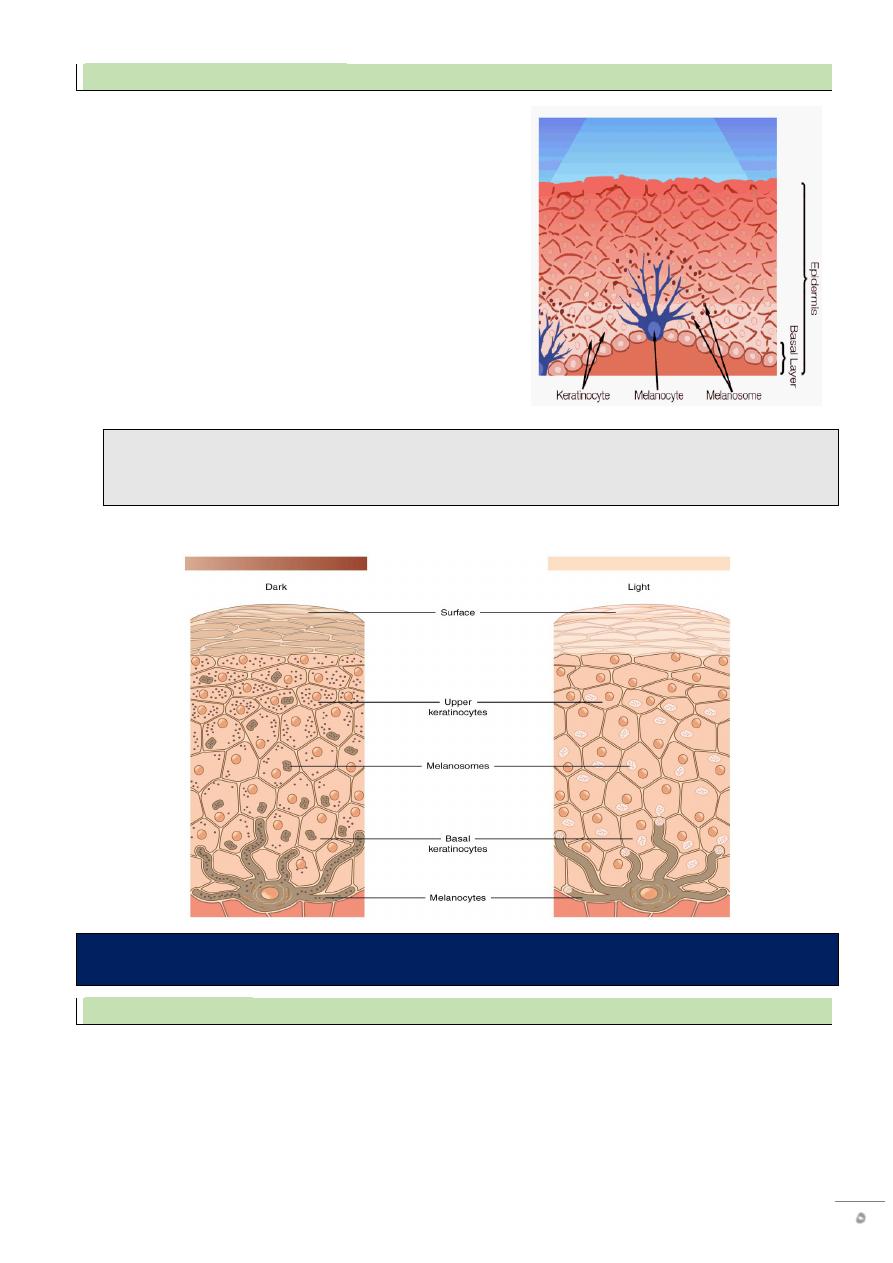
5
Dendritic cells: 1- melanocytes
• Dendritic cells of neuronal origin localized
between basal cells at a rate of one in ten, fixed
in all races
• Contain melanosomes: specialized organelles
that synthetize melanin from tyrosine under
action of tyrosinase enzyme then transfer it to
surrounding keratinocytes, forming epidermal-
melanin unit
Melanosomes are responsible for the difference in normal skin color between races;
being more in no.
Larger & more dispersed in darker skin
Question
what would happen to the skin if tyrosinase enzyme was deficient?
2- Langerhans's cell
• Dendritic cell of mesenchymal origin, localized in suprabasal layer
• By electron microscope show Birbeck granules in cytoplasm
• Antigen presenting cell in the skin: process antigens encountered on skin & present it
to local lymph nodes, thus have a key role in adaptive immune response.
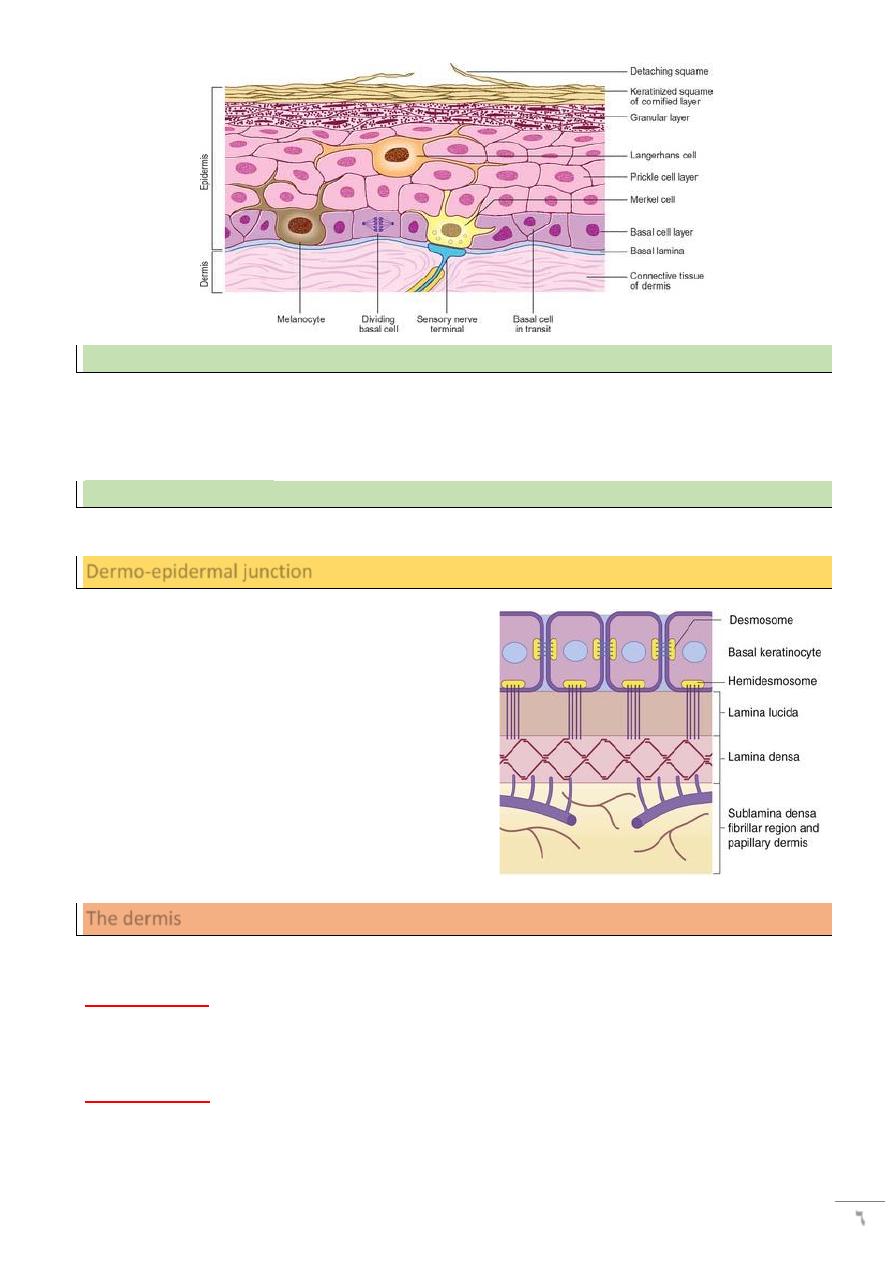
6
3- Merkel’s cells:
• Dendritic cells localized between basal cells directly above basement membrane
• Associated with unmyelinated nerve endings & act as mechano-sensory receptors in
response to touch
4- Indeterminate cells:
They have the same ultrastructure of Langerhans’s cells but without Birbeck granules
Dermo-epidermal junction
In light microscope is one layer, actually it is 3
layers:
The upper part is formed by the basement
membrane of basal layer with its attached
hemidesmosomes
Lamina Lucida
Lamina densa
Sub laminal fibrous band
The dermis
Dermis organization
Papillary layer
Contains blood vessels,
lymphatics, sensory nerves of epidermis
Reticular layer
Contains network of collagen and elastic fibers to resist tension
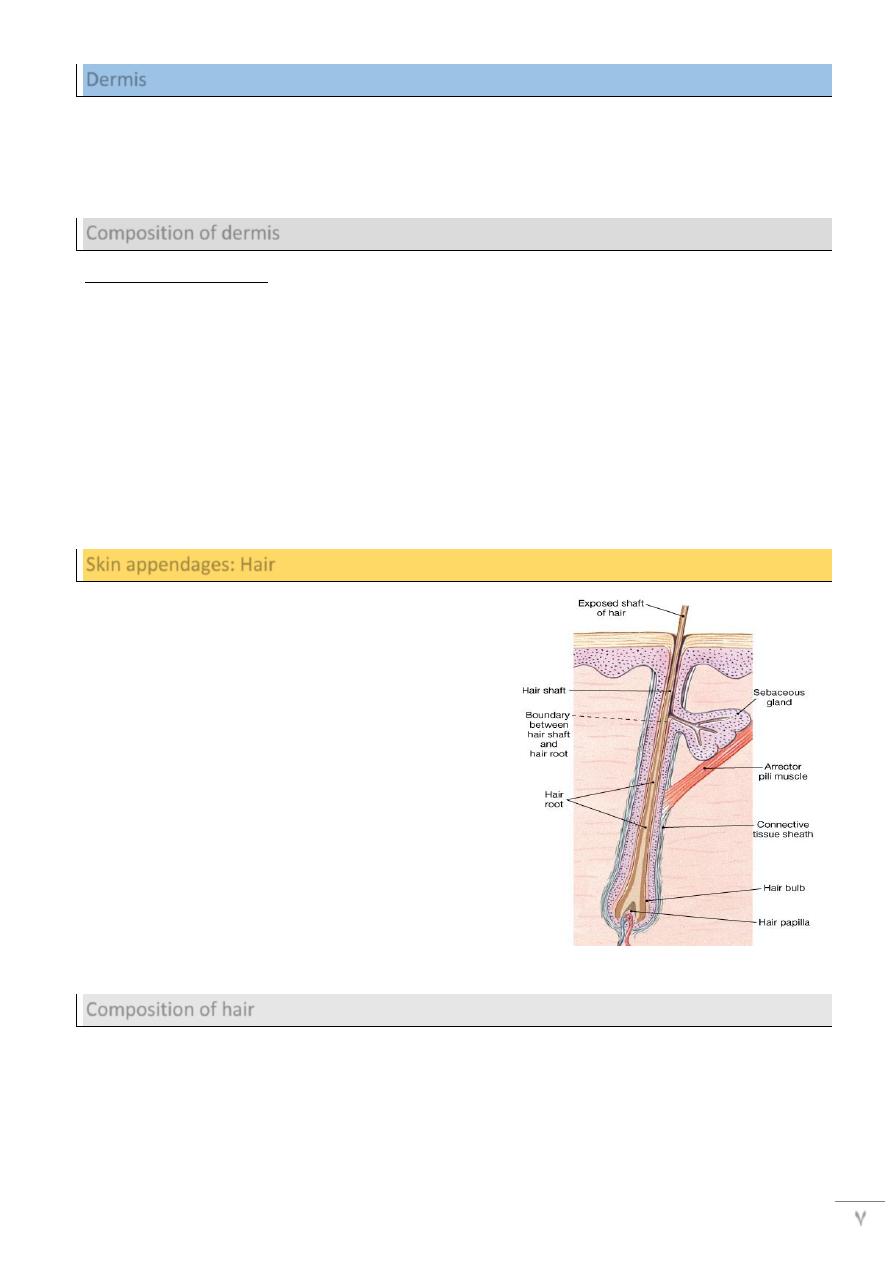
7
Dermis
The dermis forms the main bulk of the skin, lies under the epidermis & supports it both
structurally and nutritionally, they interdigitate so that upward projections of the dermis (the
dermal papillae) interlock with downward ridges of the epidermis (the rete-pegs), this
increases the force of adhesion & the contact area.
Composition of dermis
Components of dermis:
Cells: fibroblasts, mast cells, macrophages & all the cells in the blood
Fibers: 80-85% is collagen mainly type I & III, the remainder is composed of elastic &
reticular fibers
Ground substance: composed of glycosaminoglycan/ proteoglycan macromolecules,
they constitute 0.1-0.3% of the weight of dry dermis but are responsible for the
hydration of the dermis due to the high water binding capacity of hyaluronic acid.
60% of the weight of the dermis is water
Skin appendages: Hair
Hair types
1. Lanugo hair: intrauterine life, fine long hair
2. Vellus hair: peach fuzz; all over body, fine
short hair
3. Terminal hair: coarse long hair on scalp
The Anatomy of a Single Hair
Composition of hair
Originate in hair follicle
Composed of root and shaft
Root base (hair papilla) surrounded by hair bulb and root hair plexus
Hairs have soft medulla and hard cortex
Cuticle = superficial dead protective layer
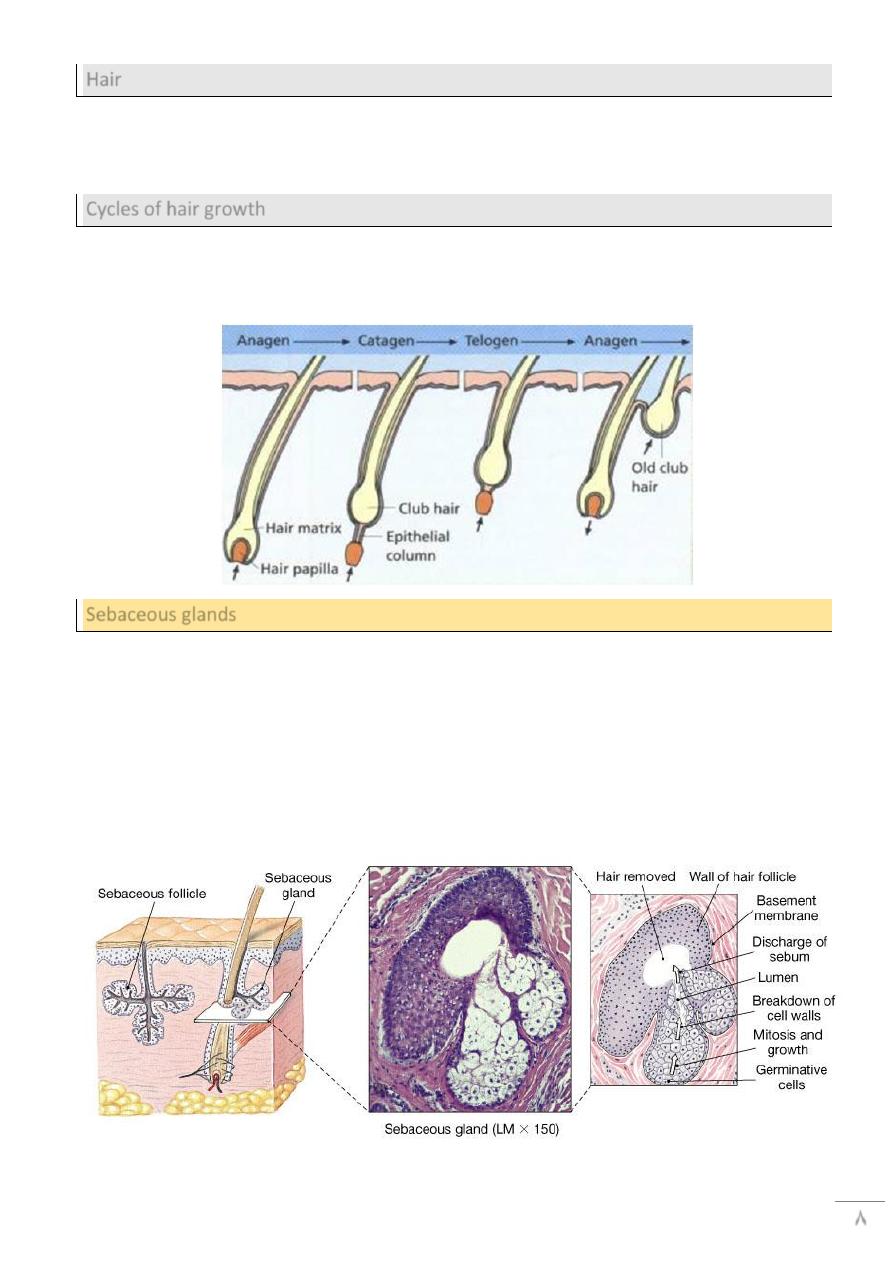
8
Hair
A bundle of smooth muscle, the arrector pili, extends at an angle between the surface of the
dermis and a point in the follicle wall. Supplied by adrenergic fibers causing hair erection during
fear, anger, & cold.
Cycles of hair growth
Anagen: growth phase lasts 2-3 years
Catagen: transition phase 2-3 weeks
Telogen: resting phase 2-3months, after which a club hair is shed
Sebaceous glands
Present all over body but mostly in seborrheic areas: scalp, face, upper part of: chest,
shoulders & back
Attached to hair follicles
Secrete sebum: a complex lipid which is bactericidal & fungistatic
Holocrine type of secretion: degeneration of the whole gland after it is filled &
release of sebum
Pilosebaceous follicles
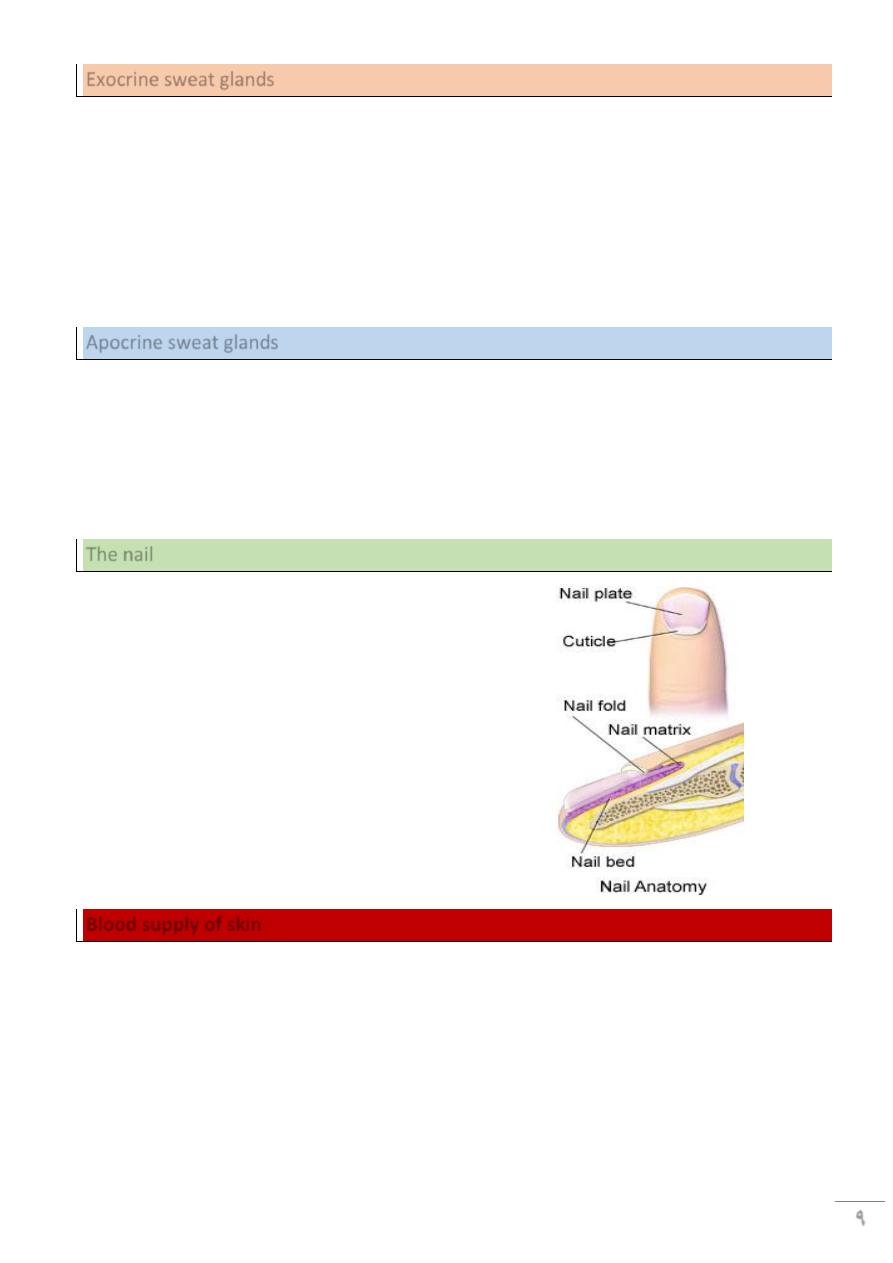
9
Exocrine sweat glands
2-4 millions
All over body, mostly palms, soles & axillae
Two parts :
1- the secretory coil deep in the dermis
2- the duct: extends from the gland & opens directly onto skin surface independent of
hair follicles
Sweat glands are innervated by cholinergic fibers of the sympathetic nervous system
Important in thermoregulation
Apocrine sweat glands
modified sweat glands limited to the axillae, nipples, periumbilical area, perineum &
genitalia
Opens directly into hair follicle
Secretion by decapitation
Responsible for the odor of the body
Under action of androgen hormone
The nail
1- Nail plate
2- Nail matrix
3- Nail bed
4- Nail folds
5- The cuticle
Blood supply of skin
The dermis is the source of nutrition of the skin, the blood vessels lie in 2 horizontal layers:
1- The deep plexus: just above the subcutaneous fat
2- A superficial plexus: in the papillary dermis with interconnecting channels between the
two.
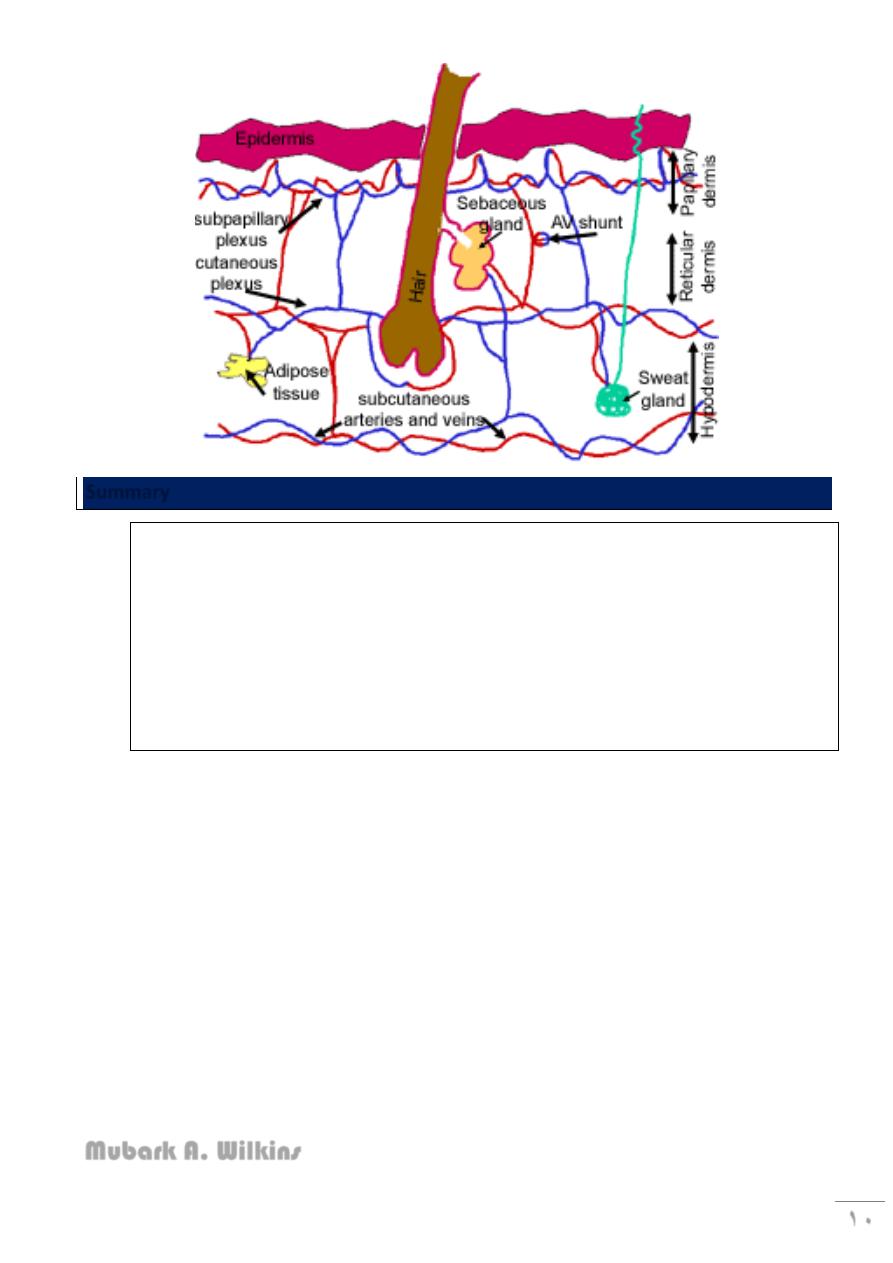
10
Summary
Now you should be familiar with:
The components of the integumentary system, including their physical relationships.
The functions of the integumentary system.
The main features and functions of the epidermis and dermis.
The structure and function of the various accessory organs of the skin.
Mubark A. Wilkins

11
